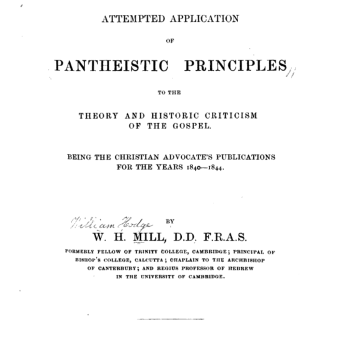The Actual Biblical Data Brought to Bear, Rather Than Late (Post-Luther and Post-Calvin) Protestant Traditions of Men

Protestant anti-Catholic apologist and polemicist Jason Engwer follows the standard theologically liberal take that Jesus had literal blood brothers / siblings. This was not Martin Luther’s or John Calvin’s view. It didn’t come from classic, original Protestantism, but from skeptical theological liberalism hundreds of years later.
Jason wrote an article entitled, “Some Undesigned Coincidences Related To Peter’s Names” (9-19-21) that presupposed the existence of siblings of Jesus. His words will be in blue:
[T]wo of the gospels report that Jesus had a brother named Simon (Matthew 13:55, Mark 6:3), . . . the two gospels that name Jesus’ brothers. Even in Matthew and Mark, the reference to a brother named Simon is brief and occurs in passing, and that brother didn’t have the sort of later prominence that James and Jude had.
. . . both Jesus and James were drawing a connection to the name of one of their brothers, . . . Simon was their youngest brother. . . . Youngest children often get treated differently because of their status as the youngest. Jesus may have had more affection for his brother Simon accordingly. . . . The angel didn’t have a brother named Simon, as Jesus and James did.
Okay. Why don’t we take a look at the two passages he cites, and cross-reference them to other related ones, to see if it makes any sense to believe that all four persons mentioned were Jesus’ literal siblings. Protestants always want the Bible first and foremost. I’m happy to bring up much more of it (relevant to the topic) than Jason does.
Matthew 13:55-56 (RSV) Is not this the carpenter’s son? Is not his mother called Mary? And are not his brothers James and Joseph and Simon and Judas? [56] And are not all his sisters with us? . . .
Mark 6:3 “Is not this the carpenter, the son of Mary and brother of James and Joses and Judas and Simon, and are not his sisters here with us?” . . .
***
Matthew 27:55-56 There were also many women there [at the crucifixion], looking on from afar, who had followed Jesus from Galilee, ministering to him; [56]among whom were Mary Mag’dalene, and Mary the mother of James and Joseph, . . .
Mark 15:40-41 There were also women looking on from afar, among whom were Mary Mag’dalene, and Mary the mother of James the younger and of Joses, and Salo’me, [41] who, when he was in Galilee, followed him, and ministered to him; . . .
John 19:25 . . . standing by the cross of Jesus were his mother, and his mother’s sister, Mary the wife of Clopas, and Mary Mag’dalene.
Therefore, “brothers” James and Joseph are the sons of Mary, wife of Clopas. This other Mary (Mt 27:61; 28:1) is called Our Lady’s adelphe [Greek for brother or sister or more distant relative, kin, friend, etc.] in John 19:25. Assuming that there are not two women named “Mary” in one family (which seems reasonable!), they cold then be Jesus’ “cousins” (beyond first cousin) or more distant relatives. Matthew 13:55-56 and Mark 6:3 mention Simon, Jude and “sisters” along with James and Joseph, calling all adelphoi.
The most plausible interpretation of all this related data is a use of adelphos as “cousins” rather than “siblings.” We know for sure, from the above information, that James and Joseph were not Jesus’ siblings.
But there is another option, too. Eusebius, in his History of the Church (III, 2), documents Hegesippus (c. 110 – c. 180) stating that Clopas (husband of Mary’s sister) was the brother of Joseph, her husband. That would make this “other Mary” the Blessed Virgin Mary’s sister-in-law, and her sons (James and Joseph named), Jesus’ first cousins.
Neither Hebrew nor Aramaic have words for “cousin.” The New Testament was written in Greek, which does have such a word (sungenis), but Jesus and His disciples spoke Aramaic (a late version of Hebrew), and the Hebrew word ach is literally translated as adelphos, the literal equivalent of the English “brother.” In the Bible, it has a very wide range of meanings beyond “sibling”: just as “brother” does in English. Thus, it is routinely used in the New Testament to describe cousins or kinsmen, etc.
It’s true that sungenis and its cognate sungenia appear in the New Testament fifteen times (sungenia: Lk 1:61; Acts 7:3, 14; sungenis: Mk 6:4; Lk 1:36, 58; 2:44; 14:12; 21:16; Jn 18:26; Acts 10:24; Rom 9:3; 16:7, 11, 21). But they are usually translated kinsmen, kinsfolk, or kindred in KJV: that is, in a sense wider than cousin: often referring to the entire nation of Hebrews. Thus, the eminent Protestant linguist W. E. Vine, in his Expository Dictionary of New Testament Words, lists sungenis not only under “Cousin” but also under “Kin, Kinsfolk, Kinsman, Kinswoman.”
Jesus Himself uses “brethren” (adelphos) in the non-sibling sense. In Matthew 23:8 (cf. 12:49-50), He calls, for example, the “crowds” and His “disciples” (23:1) “brethren.” In other words, they are each other’s “brothers”: the brotherhood of Christians.
Luke was a Greek Gentile. Paul, though Jewish, was raised in the very cosmopolitan, culturally Greek town of Tarsus. But even so, both still clearly used adelphos many times with the meaning of non-sibling:
- Luke 10:29 But he, desiring to justify himself, said to Jesus, “And who is my neighbor?”
- Acts 3:17 “And now, brethren, I know that you acted in ignorance, as did also your rulers.”
- Acts 7:23, 25-26 “When he was forty years old, it came into his heart to visit his brethren, the sons of Israel.. . . [25] He supposed that his brethren understood that God was giving them deliverance by his hand, but they did not understand. [26] And on the following day he appeared to them as they were quarreling and would have reconciled them, saying, `Men, you are brethren, why do you wrong each other?’”
- Romans 1:13 I want you to know, brethren, . . .
- Romans 9:3 For I could wish that I myself were accursed and cut off from Christ for the sake of my brethren, my kinsmen by race.
- 1 Thessalonians 1:4 For we know, brethren beloved by God, that he has chosen you;
Strikingly, it looks like every time St. Paul uses adelphos (unless I missed one or two), he means it as something other than blood brother or sibling. He uses the word or related cognates no less than 138 times in this way. Yet we often hear about Galatians 1:19: “James the Lord’s brother.” 137 other times, Paul means non-sibling, yet amazingly enough, here he must mean sibling, because (so we are told) he uses the word adelphos? That doesn’t make any sense.
Some folks think it is a compelling argument that sungenis isn’t used to describe the brothers of Jesus. But they need to examine the following passage, where sungenis appears:
Mark 6:4 And Jesus said to them, “A prophet is not without honor, except in his own country, and among his own kin, and in his own house.” (cf. Jn 7:5: “For even his brothers did not believe in him”)
What is the context? Let’s look at the preceding verse, where the people in “his own country” (6:1) exclaimed:
Mark 6:3 “Is not this the carpenter, the son of Mary and brother of James and Joses and Judas and Simon, and are not his sisters here with us?” And they took offense at him.
If Jude (Mt 13:55 and Mk 6:3 above) is the same Jude who wrote the epistle bearing that name (as many think), he calls himself “a servant of Jesus Christ and brother of James” (Jude 1:1). Now, suppose for a moment that he was Jesus’ blood brother. In that case, he refrains from referring to himself as the Lord’s own sibling (we are told that such a phraseology occurs several times in the New Testament, referring to a sibling relationship) and chooses instead to identify himself as James‘ brother.
This is far too strange and implausible to believe. Now that we have seen that James is Jesus’ cousin (either first or more distant), then if Jude is his sibling (assuming that is the meaning of Jude 1:1), then he is also Jesus’ cousin (the same sort of cousin as James).
Moreover, James also refrains from calling himself Jesus’ brother, in his epistle (James 1:1: “servant of God and of the Lord Jesus Christ”): even though St. Paul calls him “the Lord’s brother” (Gal 1:19).
This is serious and [what we used to call as evangelicals] “meaty” Bible study, not the highly selective, “milky” and surfacey fluff of Jason Engwer. He wouldn’t know in-depth Bible study if it hit him on the head. And he (knowing better, from past experience, including leaving right in the middle of a widely advertised written debate) won’t interact with this, because he ignores every reply I make to his arguments, and (can’t be too safe!) I am banned on his Tribalblogue site (not one of the “tribe”!).
We have, then, either compelling or very good, plausible biblical arguments showing that neither James, Joseph, nor Jude are Jesus’ siblings. The only named “brother” left to explain is the fourth one named Simon: the one Jason Engwer blithely assumes is Jesus’ sibling in his remarks above. In his case, we only have indirect deduction from the biblical data, as to his exact relation to Jesus (analogy to James and Joseph). But we have strong early Christian tradition, from the best historian in the early Church: Eusebius, who, in the same passage cited above, wrote:
After the martyrdom of James and the capture of Jerusalem which instantly followed, there is a firm tradition that those of the apostles and disciples of the Lord who were still alive assembled from all parts together with those who, humanly speaking, were kinsmen of the Lord – for most of them were still living. Then they all discussed together whom they should choose as a fit person to succeed James, and voted unanimously that Symeon, son of the Clopas mentioned in the gospel narrative [note: Jn 19:25; perhaps Lk 24:18], was a fit person to occupy the throne of the Jerusalem see. He was, so it is said, a cousin of the Saviour, for Hegesippus tells us that Clopas was Joseph’s brother. (The History of the Church, translated by G.A. Williamson, Baltimore: Penguin Books, 1965, 123-124)
It turns out, then, that early tradition, from the second-century historian Hegesippus (whom we have no reason to doubt in his non-theological reporting of relationships) tells us that “Symeon” is also a son of Clopas. Thus, he is another first cousin, not a blood brother. That would identify three of these four named “brothers” as cousins, based on clear biblical evidence (James and Joseph) and a combination of sound early historical tradition and the Bible (Simon or Symeon). Jude, by other biblical evidence (see above) and plausible extrapolation is very likely no different.
***
Related Reading
Photo credit: Head of Christ, by Palma il Vecchio (c. 1480-1528) [public domain / Wikimedia Commons]
***
Summary: Ever wonder about Jesus’ “brothers” or “brethren” in the New Testament? Prima facie, it looks like they are siblings. But in-depth biblical, exegetical, & linguistic analysis proves otherwise.













